Trees and Larger Plants On Sale
Showing 1–12 of 67 resultsSorted by popularity
-
Sale!

Syzygium Paniculatum 20lt (Eugenia)
Original price was: R550.00.R395.00Current price is: R395.00.Add to cartSyzygium Paniculatum 20lt
Common Name: Eugenia Tree. Australian Brush-cherryFull Sun
Afternoon Sun
Moderate Watering
Evergreen
Fast Growing
Drought ResistantSyzygium paniculatum, commonly known as the Brush Cherry, Magenta Lilly Pilly, or Australian Cherry, is an evergreen tree or shrub native to Australia. It belongs to the Myrtaceae family and is well-regarded for its attractive foliage, colourful berries, and suitability for hedging and landscaping purposes.
Appearance: Syzygium paniculatum can grow as either a small to medium-sized tree or a dense shrub. It typically reaches heights of 3 to 15m with a spread of about 2 to 5m. The tree has an upright, compact growth habit, and its dense foliage provides good privacy and screening when used as a hedge.
Leaves: The leaves of Syzygium paniculatum are glossy, dark green, and usually have an elliptical or lanceolate shape. They are arranged opposite each other on the branches.
Flowers: The tree produces small, fluffy, cream-colored flowers that are often grouped in panicles or terminal clusters. These blooms are not particularly showy but attract pollinators like bees and butterflies.
Berries: One of the attractive features of Syzygium paniculatum is its colourful berries. After flowering, it bears small, round fruit that changes colour as it ripens. The berries start green and turn shades of pink, magenta, or deep red, depending on the variety.
Growth Requirements: The Brush Cherry thrives in full sun to partial shade and prefers well-draining soil. It is relatively hardy and adaptable, making it suitable for a wide range of climates, including coastal regions. It can tolerate light frost but may require protection in colder climates.
Uses: Syzygium paniculatum is a versatile plant often used in landscaping for hedges, screens, and privacy barriers. Its dense growth and attractive foliage make it an excellent choice for shaping and maintaining formal hedges. Additionally, the colourful berries add ornamental value to the landscape.
Pruning: Regular pruning is beneficial to maintain a neat and compact shape for hedges or to encourage bushier growth. The plant can be trimmed to the desired height and shape.
-
Sale!
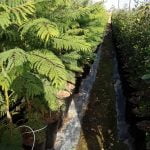
Jacaranda Mimosifolia 20lt
Original price was: R500.00.R399.99Current price is: R399.99.Add to cartJacaranda Mimosifolia 20lt
Full Sun
Semi Shade
Low Watering -
Sale!

Flowering Cherry Tree 25lt
All Plants, April Outdoor Plants On Sale, Full Sun Plants, Semi Shade Plants, Small Plants On Sale, Trees and Larger Plants On SaleOriginal price was: R950.00.R495.00Current price is: R495.00.Select options This product has multiple variants. The options may be chosen on the product pagePrunus Serrulata 25lt
Common Name: Flowering Cherry TreeNOT FOR SALE OUTSIDE OF WESTERN CAPE
Choose From These Varieties (see pictures for flowering example)
Amanogawa
Botan sakura
Fugenzo
Ichiyo
Kanzan
Mammoth Rose
Mt Fuji
Sargentii
Tai haku
Takasago
UkonPrunus serrulata, commonly known as the Japanese cherry or Oriental cherry, is a species of cherry tree native to Japan, Korea, and China. It is widely cultivated for its beautiful and abundant flowers and is one of the most iconic species associated with cherry blossom festivals.
Flowers
Colour: The flowers can be white to various shades of pink.
Type: Often double or semi-double, giving them a lush, full appearance.
Bloom Time: Typically in spring, usually late March to April depending on the climate.Leaves
Shape: Oval to lanceolate.
Colour: Emerges bronze in spring, matures to dark green in summer, and turns yellow to red in autumn.Growth Habit
Height: Can grow up to 7.0-9.0m tall.
Spread: Similar to its height, making it a broad, spreading tree.
Form: Has a rounded or vase-shaped crown.Bark
Appearance: Smooth with prominent horizontal lenticels.
Colour: Typically dark brown to reddish-brown.Growing Conditions
Soil: Prefers well-drained, fertile soil.
Light: Full sun to partial shade.
Water: Regular watering, especially during dry periods, though it is relatively drought-tolerant once established.
Climate: Thrives in temperate climates; cold hardy but can suffer in extremely hot and dry conditions.Landscaping Uses
Prunus serrulata is often planted in parks, gardens, and along streets for its ornamental value. It can be used as a specimen tree, in groups, or as part of a mixed border to create a dramatic spring display.Maintenance
Pruning: Minimal pruning required; best done after flowering to shape the tree and remove any dead or crossing branches.
Pests/Diseases: Susceptible to common pests like aphids and diseases like cherry leaf spot and powdery mildew. Regular monitoring and appropriate treatment can help maintain tree health. -
Sale!
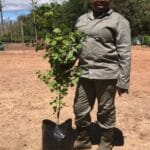
Ginkgo Biloba Tree
All Plants, April Outdoor Plants On Sale, Full Sun Plants, Herbs, Semi Shade Plants, Trees and Larger Plants On SaleOriginal price was: R750.00.R525.00Current price is: R525.00.Select options This product has multiple variants. The options may be chosen on the product pageGinkgo Biloba Tree
Common Name: Ginkgo, Ginkgo TreeGinkgo biloba, often referred to simply as “ginkgo,” is a unique and ancient tree species known for its distinctive fan-shaped leaves and its medicinal uses. It is the only surviving member of an ancient group of trees that dates back over 200 million years, earning it the nickname “living fossil.”
Appearance
Leaves: The leaves are broad, fan-shaped, and often have a unique forked or divided edge. They are bright green in the spring and summer and turn a vibrant yellow in the fall.
Size: Ginkgo trees can grow quite large, reaching up to 100 feet (30 meters) tall, although cultivated varieties are often smaller.
Bark: The tree’s bark is grayish-brown and is often considered quite resilient, resistant to pollution, and fungal diseases.
Flowers: Ginkgo is dioecious, meaning there are male and female trees. Male trees produce small, inconspicuous pollen cones, while female trees bear ovules that eventually produce seeds, which are encased in a fleshy, fruit-like structure.Habitat
Ginkgo trees are native to China, but they are now cultivated in many parts of the world due to their hardiness and resistance to pests and diseases.
They are well-suited for urban environments, thriving in areas with air pollution and poor soil.Medicinal Uses
Leaf Extract: The leaves of the Ginkgo biloba tree are commonly used in herbal medicine. Ginkgo extract is believed to improve cognitive function, memory, and circulation, though scientific studies have shown mixed results. It is often marketed as a supplement for improving mental clarity and alleviating symptoms of dementia, anxiety, and depression.
Antioxidant Properties: Ginkgo is known for its antioxidant content, which may help protect cells from damage.
Circulatory Benefits: Some studies suggest that ginkgo may improve blood flow and help with issues like cold hands and feet or varicose veins.Cultural Significance
The Ginkgo biloba is revered in many cultures, especially in Asia, where it symbolizes longevity and resilience.
It is often planted in temples and sacred areas because of its long life span and ability to survive in adverse conditions.Toxicity of Fruit
While the leaves are often used for medicinal purposes, the fruit (the fleshy seed coating) of the female Ginkgo tree can be toxic if consumed in large quantities. It contains compounds that may cause skin irritation and gastrointestinal distress, though the seed inside is typically safe when properly prepared.
Growth and Care
Ginkgo trees are hardy and tolerant of a variety of soils, but they prefer well-drained, slightly acidic soil.
They can tolerate full sun or partial shade and are drought-tolerant once established.
Ginkgo trees are relatively low-maintenance and have few pest problems, making them excellent for ornamental landscaping in cities. -
Sale!

Num Num 20lt
All Plants, April Outdoor Plants On Sale, Full Sun Plants, Hedging Plants, Indigenous Plants, Trees and Larger Plants On Sale, Water Wise PlantsOriginal price was: R550.00.R349.99Current price is: R349.99.Add to cartCarissa Macrocarpa 20lt
Common Name: Num Num Plant, Natal PlumFull Sun
Afternoon Sun
Wind Tolerant
Drought Tolerant
Easy To Grow
Low Watering
Indigenous
EvergreenCarissa Macrocarpa, commonly known as Natal Plum or Large Num-Num, is a species of flowering shrub native to South Africa. It belongs to the Apocynaceae family, which also includes other well-known plants like frangipani and oleander. The specific epithet “macrocarpa” refers to its large fruit size.
Appearance: Natal Plum is an evergreen shrub with glossy, dark green, leathery leaves. It can reach a height of about 2 to 3 meters.
Flowers: The plant produces attractive, star-shaped, white flowers that have a sweet fragrance. These flowers are typically around 2.5 cm in diameter and bloom in clusters.
Fruit: One of the distinguishing features of this plant is its large, edible fruit. The fruits are spherical, about the size of a small plum (2-4 cm in diameter), and turn from green to deep red or purplish-black when ripe. The fruit is juicy, with a mildly sweet flavour, and is often used in jams, jellies, and desserts.
Uses: In addition to being grown for its ornamental value due to its attractive flowers and glossy foliage, Natal Plum is also cultivated for its fruit. The fruit is a popular ingredient in traditional South African cuisine and is used to make preserves and alcoholic beverages.
Growing conditions: Natal Plum prefers warm, subtropical to tropical climates and is well-suited to coastal areas. It thrives in full sun or partial shade and requires well-draining soil. It can tolerate periods of drought once established, making it relatively low-maintenance.
-
Sale!
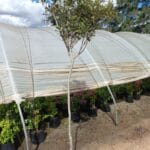
Rapanea Melanophloeos 20lt
Original price was: R650.00.R495.00Current price is: R495.00.Add to cartRapanea Melanophloeos 20lt
Common Name: Cape Beech TreeRapanea melanophloeos, commonly known as Cape Beech, is an evergreen tree native to South Africa. It is valued for its dense foliage, smooth bark, and small purple berries, which attract birds and wildlife. It is often used in gardens, parks, and as a street tree due to its hardy nature and aesthetic appeal.
Botanical Information
Growth Form: Medium to large evergreen tree
Mature Size: Up to 15-20 meters in height in natural forests, but often smaller in urban settings
Bark: Dark brown to black, smooth when young, rougher with age
Leaves: Glossy, dark green, lance-shaped, and slightly wavy at the edges
Flowers: Small, inconspicuous, creamy-green flowers (spring to summer)
Fruits: Small, purple-black berries, attractive to birdsGrowing Conditions
Climate: Tolerates a wide range of conditions; prefers mild to warm climates
Sunlight: Grows well in full sun to partial shade
Soil: Prefers well-drained, loamy soil, but adapts to various soil types
Watering: Moderate water requirements; drought-resistant once established
Frost Tolerance: Moderate; young trees may need protection -
Sale!

Lavender 20lt
Original price was: R495.00.R349.99Current price is: R349.99.Add to cartLavender 20lt
-
Sale!

Bougainvillea Jennifer Fernie 20lt
All Plants, April Outdoor Plants On Sale, Climbing Plants, Full Sun Plants, Hedging Plants, Semi Shade Plants, Trees and Larger Plants On Sale, Water Wise PlantsOriginal price was: R550.00.R449.99Current price is: R449.99.Add to cartBougainvillea Jennifer Fernie 20lt
Full Sun
Semi Shade
Wind Tolerant
Low Watering
Drought Resistant
Water Wise
EvergreenAn easy to grow bougainvillea which flowers with beautiful clusters of white coloured flowers.
-
Sale!
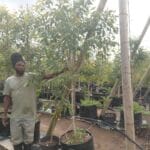
Syzygium Guineense 125lt
100-200lt Trees, All Plants, April Outdoor Plants On Sale, Full Sun Plants, Indigenous Plants, Trees and Larger Plants On SaleOriginal price was: R3,750.00.R2,350.00Current price is: R2,350.00.Add to cartSyzygium Guineense 125lt
Common Name: WaterpearFull Sun
Indigenous
Medium Watering
Wind TolerantSyzygium guineense, commonly known as Waterberry, Water Pear, or African Waterpear, is a species of tree belonging to the Myrtaceae family. It is native to various regions in Africa, including parts of West Africa, East Africa, and southern Africa. The Waterberry tree is valued for its edible fruits and is often found growing near water sources, such as rivers and lakes.
Appearance: Syzygium guineense is a medium-sized to large tree that can reach heights of 10 to 30m. It has a rounded crown with dense foliage.
Leaves: The leaves of the Waterberry tree are simple, opposite, and elliptical in shape. They are dark green and have a glossy appearance.
Flowers: The tree produces small, cream-colored or white flowers that are arranged in panicles or clusters. The flowers are usually not showy but are an important source of nectar for pollinators.
Fruits: The most significant feature of Syzygium guineense is its edible fruit, which is known as Waterberry or Water Pear. The fruits are small, round, and turn from green to purple-black when ripe. They have a sweet and slightly tart flavour and are enjoyed fresh or used to make jams, jellies, and beverages.
Growth Requirements: Waterberry trees prefer well-draining soil and are commonly found growing in areas with access to water, such as riverbanks and wetlands. They can tolerate both full sun and partial shade.
Uses: The fruits of Syzygium guineense are an important food source for both humans and wildlife, including birds and various mammal species. In some regions, the bark and leaves of the tree have also been used for medicinal purposes.
Wildlife Attraction: The Waterberry tree is attractive to birds and other wildlife, which feed on its fruits and disperse its seeds, contributing to its ecological significance.
-
Sale!

Ceratonia Siliqua 20lt
Original price was: R550.00.R379.99Current price is: R379.99.Add to cartCeratonia Siliqua 20lt
Common Name: Carob Tree, Locust TreeFull Sun
Semi Shade
Medium Watering
Drought Resistant
Evergreen TreeCeratonia siliqua, commonly known as the carob tree, is a flowering evergreen tree in the Fabaceae family. It is native to the Mediterranean region, including parts of Southern Europe, Northern Africa, and the Middle East.
Botanical Characteristics
Leaves: The carob tree has compound leaves with 4-10 oval leaflets that are glossy and dark green.
Flowers: The tree produces small, red-tinted flowers that are either male, female, or hermaphroditic.
Fruit: The carob tree is best known for its edible pods, which are long, brown, and leathery. These pods contain a sweet pulp and several hard seeds.Growing Conditions
Climate: Carob trees thrive in warm, dry climates typical of the Mediterranean region. They are drought-tolerant and can grow in poor soils.
Soil: While they prefer well-drained, sandy, or loamy soils, carob trees can also grow in rocky and less fertile soils.
Watering: Carob trees are highly drought-resistant once established, requiring minimal water.Uses
Culinary: The pods are often ground into carob powder, which is used as a cocoa substitute in various recipes, including baked goods, beverages, and confectionery. The seeds are used to produce locust bean gum, a common thickening agent in food products.
Animal Feed: The pods are also used as livestock feed due to their high nutritional content.
Other Uses: The wood of the carob tree is hard and can be used for carpentry, while the leaves and pods have been used in traditional medicine.Nutritional and Health Benefits
Nutrient-Rich: Carob is high in fibre, calcium, and antioxidants. It is low in fat and does not contain caffeine or theobromine, making it a suitable chocolate alternative for people sensitive to these substances.
Digestive Health: The high fibre content aids in digestion and can help regulate blood sugar levels.
Heart Health: The antioxidants in carob can contribute to cardiovascular health by reducing oxidative stress and inflammation.Carob trees are valued not only for their versatility and nutritional benefits but also for their ecological role in sustainable agriculture, especially in arid and semi-arid regions.
-
Sale!
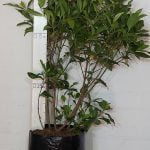
Gardenia Floribunda 20lt
All Plants, April Outdoor Plants On Sale, Full Sun Plants, Semi Shade Plants, Small Plants On Sale, Trees and Larger Plants On SaleOriginal price was: R650.00.R395.00Current price is: R395.00.Add to cartGardenia Floribunda 20lt
Full Sun
Semi Shade
Medium Watering
EvergreenGardenia floribunda, commonly known as Forest Gardenia or Wild Gardenia, is a species of flowering plant in the Rubiaceae family. It is native to various regions in Southeast Asia and the Pacific Islands. Gardenia floribunda is a small to medium-sized tree or shrub, highly valued for its fragrant and beautiful white flowers.
Appearance: Gardenia floribunda is a slow-growing evergreen shrub or small tree that can reach heights of 2 to 6m. It has a dense, compact growth habit with shiny, dark green leaves that are lanceolate or elliptical in shape.
Flowers: One of the main attractions of Gardenia floribunda is its fragrant white flowers. The flowers are usually large, trumpet-shaped, and have a waxy texture. They typically have five or six petals and emit a sweet, intense fragrance, especially in the evening. The flowers can appear throughout the year, but they are most abundant during the flowering season.
Fragrance: The strong, sweet fragrance of Gardenia floribunda flowers is highly prized and often used in perfumery and the creation of scented products.
Growth Requirements: Forest Gardenia thrives in warm, tropical or subtropical climates. It prefers well-draining, slightly acidic soil and typically grows best in full sun to partial shade. Regular watering and humidity are beneficial for its overall health and flowering performance.
Uses: Gardenia floribunda is commonly grown as an ornamental plant in gardens, parks, and landscapes. Its attractive foliage and beautifully scented flowers make it a popular choice for those who seek a sensory-rich garden experience.
Wildlife Attraction: The fragrant flowers of Gardenia floribunda attract various pollinators, including bees and butterflies, which contribute to its ecological significance.
-
Sale!

Grewia Occidentalis 25lt Pot
All Other Fruits, All Plants, April Outdoor Plants On Sale, Full Sun Plants, Semi Shade Plants, Trees and Larger Plants On SaleOriginal price was: R650.00.R349.99Current price is: R349.99.Add to cartGrewia Occidentalis 25lt Pot
Common Name: Cross BerryGrewia occidentalis is a shrub or small tree native to Southern Africa. It belongs to the Malvaceae family and is known for its attractive foliage and edible fruits.
Growth Form
Grewia occidentalis can grow as a shrub or small tree, typically reaching about 3–5 meters in height. It has a bushy appearance with a spreading canopy.Leaves
The leaves are ovate, rough-textured, and have a greyish-green colour. They are arranged alternately and have a slightly velvety feel.Flowers
The plant produces small, five-petaled flowers that are usually pink to purple in colour. The flowers are quite attractive and are a favourite for bees and other pollinators.Fruit
The fruit of Grewia occidentalis is small, round, and orange-yellow in colour. It resembles a small mango, hence the common name “Wild Mango.” The fruit is edible and has a sweet, tangy taste but is often fibrous.Habitat
It is found in various environments, from savannas to rocky hillsides, and is well-adapted to dry, drought-prone areas. It can grow in well-drained soils and is often found in areas with seasonal rainfall.Uses
Culinary: The fruit is eaten raw, and in some cultures, it is made into jams, juices, or dried for later use.
Medicinal: In some parts of Africa, parts of the plant are used in traditional medicine for various ailments.
Ornamental: The plant is sometimes cultivated for its attractive flowers and fruit, especially in ornamental gardens or wildlife-friendly landscapes.Growing Conditions
Soil: Grewia occidentalis thrives in well-draining soils. It is drought-tolerant but benefits from regular watering during dry spells.
Sunlight: It prefers full sun to partial shade.
Temperature: It is suited to warm climates and can tolerate mild frost once established.Grewia occidentalis is relatively low-maintenance, making it a good choice for xeriscaping or for gardeners looking to grow a drought-resistant plant with aesthetic and functional benefits.
